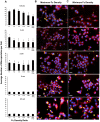Effects of microparticle size and Fc density on macrophage phagocytosis
- PMID: 23630577
- PMCID: PMC3632606
- DOI: 10.1371/journal.pone.0060989
Effects of microparticle size and Fc density on macrophage phagocytosis
Abstract
Controlled induction of phagocytosis in macrophages offers the ability to therapeutically regulate the immune system as well as improve delivery of chemicals or biologicals for immune processing. Maximizing particle uptake by macrophages through Fc receptor-mediated phagocytosis could lead to new delivery mechanisms in drug or vaccine development. Fc ligand density and particle size were examined independently and in combination in order to optimize and tune the phagocytosis of opsonized microparticles. We show the internalization efficiency of small polystyrene particles (0.5 µm to 2 µm) is significantly affected by changes in Fc ligand density, while particles greater than 2 µm show little correlation between internalization and Fc density. We found that while macrophages can efficiently phagocytose a large number of smaller particles, the total volume of phagocytosed particles is maximized through the non-specific uptake of larger microparticles. Therefore, larger microparticles may be more efficient at delivering a greater therapeutic payload to macrophages, but smaller opsonized microparticles can deliver bio-active substances to a greater percentage of the macrophage population. This study is the first to treat as independent variables the physical and biological properties of Fc density and microparticle size that initiate macrophage phagocytosis. Defining the physical and biological parameters that affect phagocytosis efficiency will lead to improved methods of microparticle delivery to macrophages.
Conflict of interest statement
Figures







References
-
- Aderem A, Underhill DM (1999) Mechanisms of phagocytosis in macrophages. Annu Rev Immunol 17: 593–623. - PubMed
-
- Underhill DM, Ozinsky A (2002) Phagocytosis of microbes: complexity in action. Annu Rev Immunol 20: 825–852. - PubMed
-
- Gordon S, Taylor PR (2005) Monocyte and macrophage heterogeneity. Nature Reviews Immunology 5: 953–964. - PubMed
-
- Hodge S, Hodge G, Brozyna S, Jersmann H, Holmes M, et al. (2006) Azithromycin increases phagocytosis of apoptotic bronchial epithelial cells by alveolar macrophages. Eur Respir J 28: 486–495. - PubMed
-
- Harris M (2004) Monoclonal antibodies as therapeutic agents for cancer. Lancet Oncology 5: 292–302. - PubMed
Publication types
MeSH terms
Substances
Grants and funding
LinkOut - more resources
Full Text Sources
Other Literature Sources

